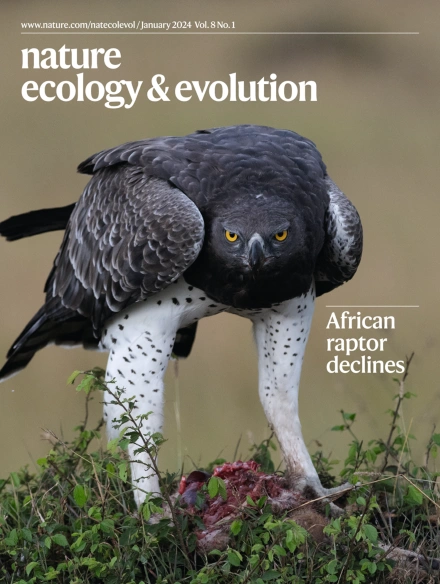学会使用鸟类天生的音-义联系。
IF 13.9
1区 生物学
Q1 ECOLOGY
引用次数: 0
摘要
声音交流系统中的信号有先天的也有后天的。虽然先天信号和习得信号通常被认为是独立的,但达尔文推测它们可能在进化上是相关的,前者是后者的基础,甚至在我们自己的交流系统——语言中也是如此。在这里,我们通过研究寄生物的鸟类宿主的声音交流系统来验证这一假设。首先,我们证明了21种鸟类在大约5300万年的进化中对各自的幼虫寄生虫产生结构相似的“呜呜”发声。在探索哀鸣发声产生的社会相关性时,我们发现产生这种发声的物种通常存在于寄生虫-宿主网络密集的地区,这表明它的产生促进了宿主物种之间的相互作用。跨三大洲的实验表明,这种鸣叫是针对多种寄主物种的幼虫的,听到它们会引起先天的快速招募反应,来自不同大陆的寄主物种对彼此的鸣叫反应相同,表明趋同使用促进了物种间的合作防御。我们的结果提供了一个参考动物发声的例子,在正确的环境中,声音的产生是后天习得的,但听到它会引起先天反应,代表先天和习得信号之间的中间。本文章由计算机程序翻译,如有差异,请以英文原文为准。
Learned use of an innate sound-meaning association in birds.
Signals in vocal communication systems range from innate to learned. Although innate and learned signals are often assumed to be independent, Darwin speculated that they could be evolutionarily related, with the former being the foundation of the latter even in our own communication system, language. Here we test this hypothesis by studying the vocal communication systems of avian hosts of brood parasites. First, we show that 21 bird species separated by approximately 53 million years of evolution produce structurally similar 'whining' vocalizations towards their respective brood parasites. Exploring the social correlates of whining vocalization production, we find that species that produce this vocalization often exist in areas with dense parasite-host networks, suggesting that its production facilitates interactions among host species. Experiments across three continents show that this vocalization is referential towards brood parasites in multiple host species, that hearing them elicits an innate rapid recruiting response, and that host species from different continents respond equally to the whining vocalizations of each other, indicating that convergent use facilitates cooperative defences across species. Our results provide an example of a referential animal vocalization for which sound production in the correct context is learned but for which hearing it elicits an innate response, representing an intermediate between innate and learned signals.
求助全文
通过发布文献求助,成功后即可免费获取论文全文。
去求助
来源期刊

Nature ecology & evolution
Agricultural and Biological Sciences-Ecology, Evolution, Behavior and Systematics
CiteScore
22.20
自引率
2.40%
发文量
282
期刊介绍:
Nature Ecology & Evolution is interested in the full spectrum of ecological and evolutionary biology, encompassing approaches at the molecular, organismal, population, community and ecosystem levels, as well as relevant parts of the social sciences. Nature Ecology & Evolution provides a place where all researchers and policymakers interested in all aspects of life's diversity can come together to learn about the most accomplished and significant advances in the field and to discuss topical issues. An online-only monthly journal, our broad scope ensures that the research published reaches the widest possible audience of scientists.
 求助内容:
求助内容: 应助结果提醒方式:
应助结果提醒方式:


